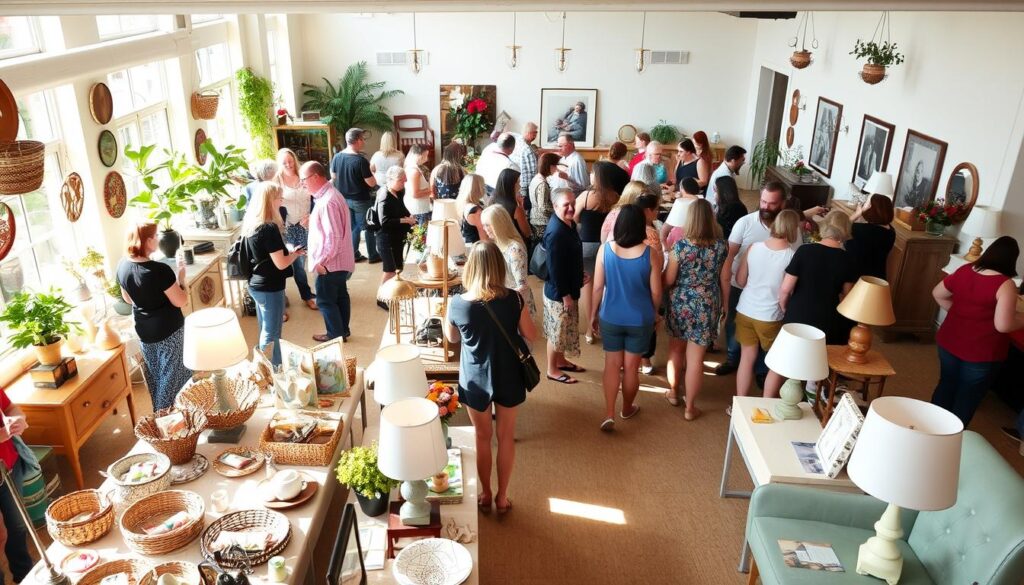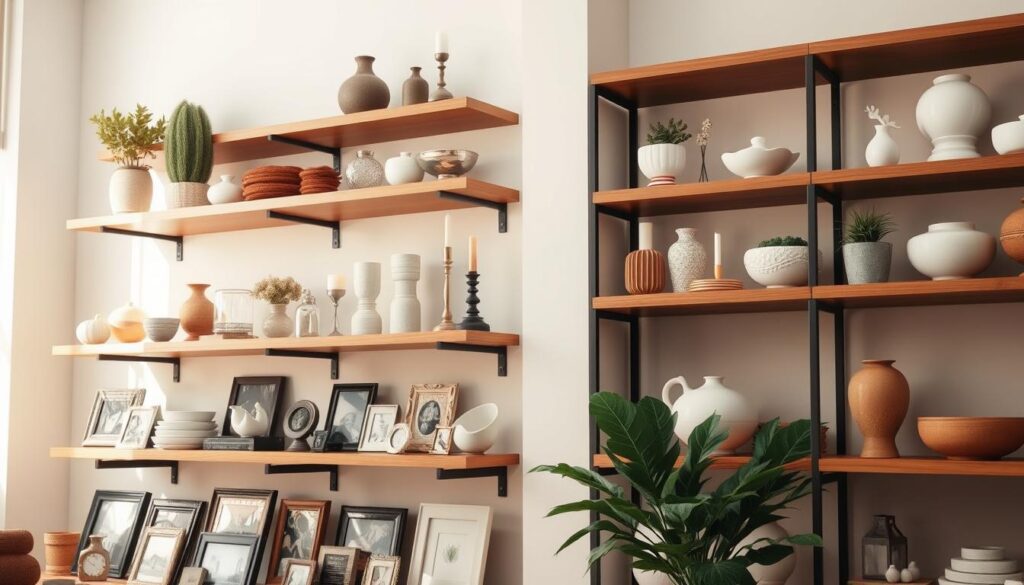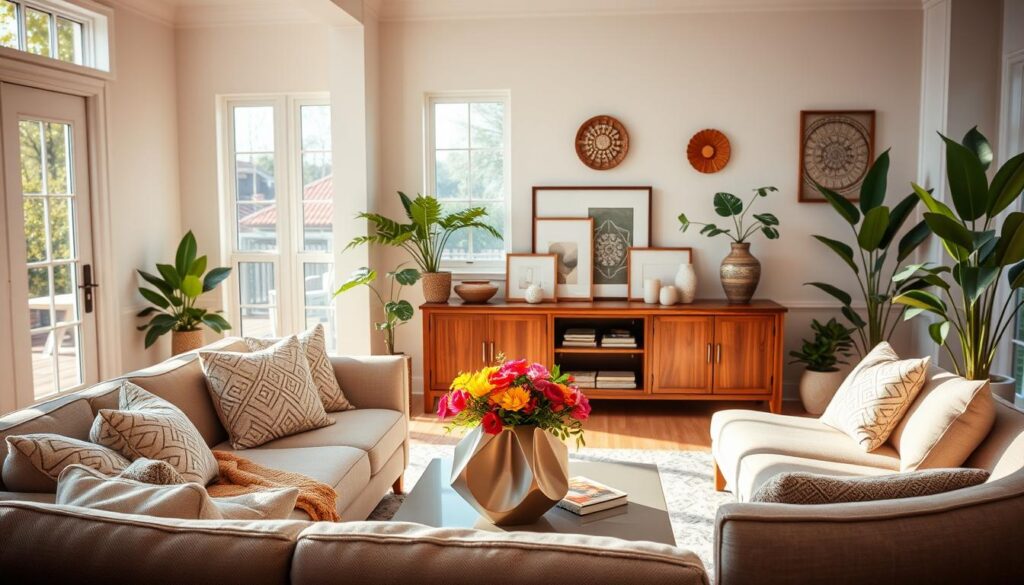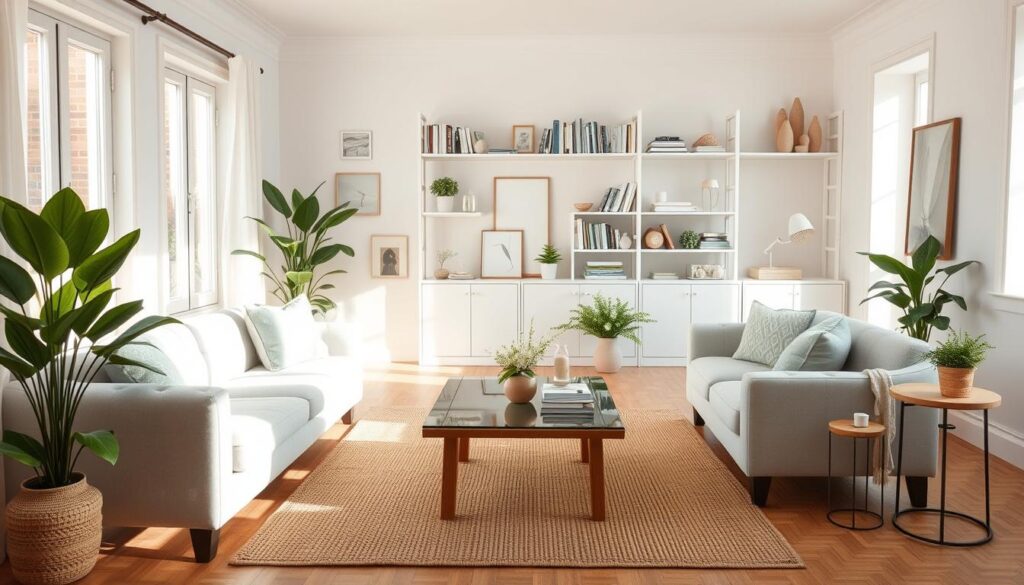What if I told you your dream space is already hidden in your home? For years, I thought refreshing my home meant spending a lot on new decor. But then I found out a secret: seasonal transformations don’t require shopping sprees—just smart swaps.
Let’s talk about textiles. Changing your bedding can totally change a room’s vibe. Designer Nathan Schroder loves bamboo sheets for their crisp feel and coolness, great for warm months. Add some light quilt covers in soft colors, and your bedroom will feel like a fancy hotel.
Throw pillows are also key. Swap them between rooms for a fresh look. That cool geometric print from your living room? Try it in the guest bedroom with a different lumbar pillow. Color coordination matters more than buying new pieces.
This way of decorating isn’t just cheap—it’s also good for the planet. You’ll get rid of clutter and find hidden gems. The best part? These changes take just a few minutes but give you that “room makeover inspiration” we all want.
Key Takeaways
- Seasonal updates cost nothing when reusing existing decor
- Textile swaps (like bedding and pillows) create instant visual impact
- High-quality bamboo sheets elevate comfort and style
- Color coordination trumps purchasing new items
- Decluttering reveals hidden design opportunities
What is a Spring Cleaning Decor Swap?
Imagine swapping that old lampshade for a bright vase. A spring cleaning decor swap is like a treasure hunt. Everyone brings items to exchange. It’s about reimagining your space and connecting with others who love design.
The Concept Behind the Swap
It’s a community-driven refresh. Kim Cornelison swapped her lampshades for modern ones through a local group. Robert Peterson changes his pillow covers seasonally without buying new ones. The goal is to give old items a new life.
Benefits of Participating
Why join a decor swap? Here are a few reasons:
- Save money: No need to spend on new items when you can trade.
- Spark creativity: Discover styles you’d never find in stores.
- Build connections: Meet neighbors who share your love for home decor.
Swapping helps me see my old decor in a new light. Last spring, I swapped a faded rug for a coastal-inspired mirror. Now, it’s the centerpiece of my entryway!
How It Promotes Sustainability
Here’s the eco-friendly part: The EPA says textile waste drops by 25% with clothing swaps. Apply that to home decor, and you’re keeping items out of landfills. My local group diverted over 200 items from trash last year.
By choosing reuse, you’re not just updating your space. You’re part of a movement that values quality over quantity. It’s one seasonal decor update at a time.
Preparing for My Decor Swap
A successful decor swap starts at home. I’ve learned to clear out the old, pick what to trade, and give items a new life. Here’s how I do it.
Decluttering My Space
I use Marie Kondo’s “spark joy” test but with a twist. Instead of holding each item, I ask:
- Does this piece make me smile when I walk into the room?
- Have I used it in the past year?
- Does it fit my current style?
Last spring, I found 15 unused throw pillows in my closet. Now, I only keep what fits on my furniture. Tip: play upbeat music while sorting—it makes the task fun.
Selecting Items to Swap
Not everything has to go. I follow this simple rule:
| Swap These | Keep These | Why |
|---|---|---|
| Duplicate vases | Sentimental pieces | Maintain personal touch |
| Outdated lamps | Versatile neutrals | Foundation for new looks |
| Unused candle holders | Quality textiles | Easy to restyle |
Jason Donnelly’s scented candle rotation idea changed my approach. Now, I swap seasonal fragrances instead of keeping them all.
Cleaning and Refreshing Decor Items
My 3-step revival process makes swap items feel new:
- Inspect: Check for chips, stains, or loose parts
- Clean: Use the right methods (wood polish, fabric refresher)
- Style: Add ribbons or fresh greenery like Annie Schlechter’s table setting hacks
I recently updated a dusty terrarium by swapping its rocks for sea glass. It shows that small changes can make a big difference!
Setting the Date and Location
Choosing the right time and place for my decor swap was key. The venue sets the mood, and the timing affects who shows up. Here’s how I got it right.
Choosing the Perfect Venue
I tried two spots: my living room and the Maplewood Community Center. At home, the cozy feel and easy furniture rearrangement were great. But for more guests, the community center’s setup was better.
Local libraries are also a good choice for eco-friendly events. They often offer free rooms.
Timing the Event
Early April was the perfect time – after spring break but before Easter and Mother’s Day. I picked a Sunday 2-5 PM slot to avoid soccer season. This allowed guests to enjoy brunch and for me to refresh swapped items the next day.
It was great to help guests update their seasonal decor before summer!
Inviting Friends and Family
My text invitation was fun and clear:
“Swap your unloved decor for fresh finds! 📅 Sun April 7 🕑 2-5 PM 📍 Maplewood Rec Room 🔄 Bring 3+ items (no stains/breaks!) 💚 Let’s keep treasures out of landfills!”
I used Evite’s eco-party template for email reminders. I also made a Facebook event with furniture rearrangement tips to inspire ideas. 78% of guests said yes after seeing my setup photos!
My Venue Prep Checklist
- 6′ folding tables (1 per 5 guests)
- Labeled sections: Wall Art • Textiles • Accents
- Lighting adjustments for decor displays
- Snack station away from swap areas
Making the Most of the Swap Event
Hosting a decor swap is more than just trading items. It’s about sparking creativity and building connections. I found that with careful planning, a simple swap can turn into a fun and inspiring event. Here’s how I made my swap day both enjoyable and useful.

Organizing the Space for Swapping
I used Carson Downing’s coffee table styling method to make displays stand out. By grouping decor into themed vignettes, participants could see how items might fit in their homes. I set up three zones:
- Seasonal Station: Spring-themed items arranged with fresh greenery
- Texture Corner: Throw pillows and blankets folded in inviting stacks
- Statement Central: Larger pieces like lamps and artwork displayed at eye level
| Zone | Display Tip | Styling Hack |
|---|---|---|
| Seasonal | Use tiered trays | Add faux buds in vases |
| Texture | Fold blankets diagonally | Layer contrasting patterns |
| Statement | Rotate items hourly | Use painter’s tape labels |
Tips for a Successful Swap Day
These tips helped my event run smoothly:
- Set clear start/end times to create urgency
- Offer reusable shopping bags for easy carrying
- Play upbeat instrumental music at low volume
I also had a “Style Consultant” rotation. Participants spent 15 minutes helping others style their swaps. This boosted confidence and led to exciting combinations!
Encouraging Participation and Engagement
Icebreakers were key. I started with a “Decor Dare” game where everyone shared the weirdest item they’d ever displayed. For shy swappers, I used:
- Trade Tokens (play money for multi-item deals)
- Collaboration Challenges (“Build a tablescape together”)
- Photo Op Corner with props for social sharing
By lunchtime, the room was buzzing with room makeover inspiration. One guest even redesigned her living room layout using our home organization tips and swapped throw pillows!
Fun Themes for My Decor Swap
Adding a creative theme to my decor swap made it more than just an exchange. Themes spark inspiration and help people see how items fit in their homes. I used seasonal decor updates and home styling hacks to add personality to my event.
Seasonal Themes to Consider
I chose nature-inspired themes for my decor swaps. “Botanical Bliss” was a hit in spring, with guests bringing planters and floral textiles. Summer’s “Coastal Breeze” theme featured Nathan Schroder’s blue-and-white palette, with nautical decor and airy linens.
Fall swaps were all about “Harvest Glow” with warm accents. Winter’s “Fireside Charm” theme brought cozy textures.
Color Schemes and Styles
I focused on specific color stories to make items feel connected. I curated:
- Vintage Neutrals: Creams, taupes, and weathered wood tones
- Modern Monochrome: Black-and-white geometric patterns
- Jewel Tone Mix: Emerald green velvet pillows with brass accents
This made it easier to mix-and-match pieces and update my home styling strategy.
DIY Decor Ideas
I used hands-on projects from my favorite sources:
- Customized lampshades with removable fabric covers (perfect for seasonal updates)
- Floating shelves arranged in dynamic “shelfie” groupings using stacking techniques
- Upcycled frames turned into mini chalkboards for kitchen organization
These projects added unique, personal touches that store-bought items couldn’t match. The DIY station was the swap’s most photographed area!
Creating a Decor Inventory
After my first decor swap, I learned the importance of organizing my items. Keeping a detailed inventory helps me track what I have, find items to swap, and prevent clutter. I created a system that blends digital ease with hands-on simplicity.

Documenting My Decor Items
I began by listing every decor piece in my home on a digital spreadsheet. I noted the type, color, condition, and sentimental value of each item. I also took photos and saved them in a cloud folder called “Decor Archive.”
Physical tags were also useful. I put removable labels on vases, frames, and trays with basic details. This method saved me a lot of time when preparing for swaps – no more wondering which items to give away!
Keeping Track of Swapped Items
During swaps, I used a color-coded sticker system to mark items that were claimed. Green stickers meant “ready to trade,” and yellow meant “pending approval.” After the swap, I updated my spreadsheet with:
- Swap dates and participant names
- Condition notes for incoming items
- Storage locations for new acquisitions
| Tracking Method | Tools Used | Time Saved Weekly |
|---|---|---|
| Digital Log | Google Sheets + Photos | 1.5 hours |
| Physical Tags | Removable Labels | 45 minutes |
| Swap Records | Color Stickers + Notes | 30 minutes |
Tips for Future Swaps
Three home organization tips that changed my inventory management:
- Update your list right after getting new items
- Declutter seasonally to refresh categories every quarter
- Store photos and documents in matching folders (e.g., “2024 Spring Swap”)
I now check my decor inventory every six weeks. This habit helps me find underused items quickly and plan swaps better. A pro tip: Add QR codes to physical tags that link to your digital records!
Strategies for Effective Trading
Learning to trade transformed my decor swap into a fun, collaborative event. Whether you’re new or experienced, these tips help everyone leave happy. Let’s explore how to make trades that benefit everyone, keeping things fun and fair.
Valuing Items and Fair Trades
I made a simple chart to weigh item value and emotional worth. For instance, my used Ethan Allen side table was worth over $300 but didn’t hold much emotional value. On the other hand, a swapper’s vintage lamps were priceless to them but less expensive. We both felt the trade was fair.
| Item Type | Replacement Cost | Emotional Value |
|---|---|---|
| Mid-Century Side Table | $320 | Low |
| Vintage Brass Lamp Set | $180 | High |
| Handmade Quilt | $75 | Extreme |
Negotiating and Bartering
My first swap taught me to ask questions instead of making demands. When I saw a bohemian rug, I found out the owner needed storage. My unused cube shelves were the perfect solution. This method is great for furniture rearrangement tips – think about how pieces can solve others’ space problems.
What to Do with Leftover Items
Last spring’s swap left me with four unclaimed picture frames. Instead of storing them, I donated them to:
- Habitat for Humanity ReStore (building materials)
- Local women’s shelter (decorative items)
- Community theater group (props)
Donating leftovers not only clears space but also helps neighbors in need. Many organizations even give tax receipts!
Incorporating New Items into My Home
Unpacking my decor swap finds was like Christmas morning. But, the real challenge was making them fit in my home. I learned that placing and styling items carefully is key to a cohesive look. Here’s how I made my space shine with swapped treasures while keeping my style.

Arranging My New Decor Pieces
I began by using the 70-20-10 decor ratio: 70% base items, 20% statement pieces, and 10% accents. This kept my space tidy while showing off my favorite finds. A swapped vintage lamp became a standout, and a large abstract painting I traded for became the room’s centerpiece.
Mixing New Finds with Existing Items
I layered thrifted pastel placemats under my neutral dinnerware, adding depth with contrasting textures. My navy curtains looked great with swapped ivory throw blankets. The trick was keeping a consistent color story and introducing new patterns with smaller items.
Styling Tips for a Fresh Look
Three strategies helped me achieve a magazine-ready room makeover inspiration:
- Group items in odd numbers (3 candlesticks on the mantel)
- Use varying heights for visual interest (stacked books under a vase)
- Leave breathing room around statement pieces
I took before/after photos to see my progress. Seeing the change was incredibly rewarding. My biggest lesson? Don’t be afraid to move things until the room feels just right.
Celebrating the Success of My Decor Swap
Months of planning led to a big change in my home. What began as a simple seasonal decor update grew into a community project. It showed me how creative changes can save money.
Reflecting on the Experience
One week after the swap, I reflected on it. I used a spring cleaning strategy to guide my thoughts. I asked three key questions:
- Which swapped item brought me the most joy?
- What feedback did others share about the process?
- How did this align with my home organization tips for 2024?
The answers were enlightening. That vintage lamp, almost kept, was a hit with three friends. It showed letting go can lead to better matches.
Sharing Photos and Ideas
I made a Google Photos album called “Spring Swap Wins.” I invited everyone to add their styled pieces. The reveal party was a hit, with lemonade and voting on favorite items.
Pro tip: Use Instagram polls for feedback if you can’t meet in person!
Planning Subsequent Swaps
The success inspired me to plan more swaps. I created a quarterly swap calendar. Here’s my plan:
| Season | Theme | Prep Focus |
|---|---|---|
| Summer | Coastal Textures | Declutter linens |
| Fall | Warm Tones | Rotate wall art |
I’ve already booked a park pavilion for October’s swap. Outdoor spaces boost energy and make organizing fun.
The Impact of Decor Swaps on Community
Hosting a decor swap changed my home and deepened friendships. It turned into a big movement. Now, my neighborhood thinks differently about being green and creative.
Building Connections with Neighbors
Our swap group did more than just share furniture tips. It inspired the local library to start a tool-sharing program. Last year, 32 families joined, showing how small steps can lead to big changes.
Sharing Tips and Tricks for Home Decoration
Everyone brought cool ideas to our swaps. One person showed us how to use tension rods for plants. Another taught us to update lampshades with fabric. These tips spread through our Facebook group, reaching over 500 members.
Encouraging Eco-Friendly Practices in My Area
In the first year, we kept 1.2 tons of items out of landfills. Our success caught the city’s recycling center’s eye. They now host swap events quarterly. We also smudge spaces with sage, making clean-outs special.
Seeing repurposed lamps or swapped paintings in friends’ homes reminds me of the power of sharing. Let your next home update spark a community project. Your couch might start the next big thing.

